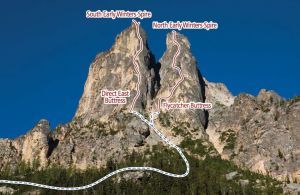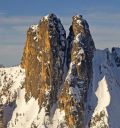Flycatcher Buttress, North Early Winters Spire IV 5.10b |
||
Washington Pass, Washington, USA | ||
| ||
|
Avg time to climb route: 4-8 hours
Approach time: 1.5-3 hours Descent time: 1.5-3 hours Number of pitches: 11 Height of route: 800' Overview
The Flycatcher Buttress on North Early Winters Spire (NEWS) is the least popular of all the East Face routes. This is due to a lack of information more than a lack of quality climbing. The last accurate topo was available in Bryan Burdo’s Kinko’s- made guide book in the mid-90s. Fred Beckey’s guide still shows the original 1965 aid route. This relatively moderate route is worth a look and certainly deserves greater popularity. At first look, The Flycatcher is big and looks more intimidating than elegant. A closer look shows it to be an adventurous outing on mostly solid rock with amazing position and quite a few quality pitches. The difficulty is comparable to the Direct East Buttress on South Early Winters Spire. The DEB is cleaner, the route finding a little more straightforward, and the difficulties more sustained while The Flycatcher sports slightly more challenging individual moves.
Photos
- View all 1 photos of Flycatcher Buttress as: Thumbnails | Slideshow
Climber Beta on Flycatcher Buttress
Find other routes like
Flycatcher Buttress
Route History
The Flycatcher was first climbed in July on 1965 by Washington Pass pioneers Steve Marts, Don McPherson, and King McPherson. They spent quite a few days on the face, and the first ascent was done mostly on aid.With stories of loose aid up to A3 and difficult route finding, the route soon faded into obscurity. Then in 1990, it came to the attention of Washington’s second most prolific route developer, Bryan Burdo. He had been free soloing several different routes in the area all summer. He examined the east buttress, eying the features on the face, not even knowing exactly where the 1965 route went. Burdo was inspired by some of the routes John Bachar put up in California, onsight, ropless, with only a chalk bag and a tooth brush for scrubbing holds. This was certainly one of the boldest and proudest ways to establish a first ascent. Burdo left the ground under sunny skies with only a chalk bag, a tooth brush, and the T-shirt on is back, telling himself he could just down climb if things went bad. As he climbed higher, the sky grew darker. About halfway up, Burdo pulled a roof that he wasn’t sure he could reverse. The wind picked up and he felt the occasional drop of rain, but with no gear and no rope, he was committed to making it to the top. He found a dead flycatcher – a small bird that hunts insects – near the summit and wondered if this was a bad omen. Less than 200 feet from the top with thunder in the distance, he ran into a section he couldn’t get around. He tried several ways out to the right but nothing went. Burdo recalls that at this point, he started to get a little worried. Then he noticed a crack system up and to the left that looked as if it might go. Not only did it go, it turned out to be fantastic climbing. He quickly topped out, and as he down climbed the chockstone gully it began to hail violently. Relieved to have survived the experience, he didn’t onsite solo again for some time. While the route Burdo climbed shared some pitches with the 1965 route, his entirely free route contained some distinct variations. It is still amazing to think how bold Burdo was to put this new 1,000 foot tall route ground-up, onsight, free solo, carrying no rope, and with virtually no previous knowledge of the old 1965 aid line. Strategy
One of the longer and trickier approaches in the Liberty Bell group combined with 1,000 feet of adventurous climbing make for a full day, so start early. The route is long and has its fair share of devious route finding, especially on Pitches 3-5 and 9 and 10. Pitch 1 is a little bold and takes a little extra effort to fiddle in good gear, but it comes only at intervals. This pitch is for solid 5.9 leaders. Protect your second on Pitch 2. The 5.10 cruxes on the route are short and you could pull through on gear if necessary. The first 5.10b crux that comes on Pitch 7 involves steep, mostly hand-sized jamming out a small roof. It is short, well-protected, and a great place to push yourself. On Pitch 10 you can climb the full body OW at 5.9 or the Twin Fly Catcher cracks at 5.10a/b; both are good. While you can pull through the cruxes on gear, the size and sustained nature of the route call for at least a solid 5.9-5.10a leader. Crowds are unlikely, but passing could be easily managed through most of the middle of the route. Expect to carry all your gear up and over with you as it is extremely inconvenient to return to the base. This route is a little dirty but was given four stars because of the length and quality rock and the climbing on several pitches is quite good.Retreat Storm
This route has no fixed anchors. You could rappel Pitch 1 with two ropes from a stout bush. After the traverse on Pitch 2, retreat would be difficult andwouldinvolvelosingalotof gear. With two ropes you would lose less gear.
Everything You Need to Know About
Washington Pass
Search the internet for beta on
Flycatcher Buttress
|
Other Routes on North Early Winters Spire
|




